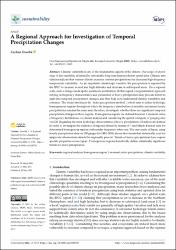A Regional Approach for Investigation of Temporal Precipitation Changes
Citation
Ozcelik, C. A Regional Approach for Investigation of Temporal Precipitation Changes. Sustainability 2021, 13, 5733. https:// doi.org/10.3390/su13105733Abstract
Climatic variability is one of the fundamental aspects of the climate. Our scope of knowledge of this variability is limited by unavailable long‐term high‐resolution spatial data. Climatic simulations indicate that warmer climate increases extreme precipitations but decreases high‐frequency temperature variability. As an important climatologic variable, the precipitation is reported by the IPCC to increase in mid and high altitudes and decrease in subtropical areas. On a regional scale, such a change needs spatio‐parametric justification. In this regard, a regionalization approach relying on frequency characteristics and parameters of heavy precipitation may provide better insight into temporal precipitation changes, and thus help us to understand climatic variability and extremes. This study introduces the “index precipitation method”, which aims to define hydrologic homogeneous regions throughout which the frequency distribution of monthly maximum hourly precipitations remains the same and, therefore, investigate whether there are significant temporal precipitation changes in these regions. Homogenous regions are defined based on L‐moment ratios of frequency distributions via cluster analysis and considering the spatial contiguity of gauging sites via GIS. Regarding the main hydrologic characteristics of heavy precipitation, 12 indices are defined in order to investigate the existence of regional trends by means of t‐ and Mann–Kendall tests for determined homogenous regions with similar frequency behaviors. The case study of Japan, using hourly precipitation data on 150 gauges for 1991–2010, shows that trends that statistically exist for single‐site observations should be regionally proved. Trends of heavy precipitation have region‐specific properties across Japan. Homogenous regions beneficially define statistically significant trends for heavy precipitation


















